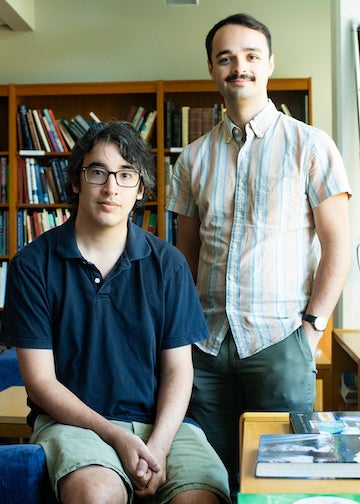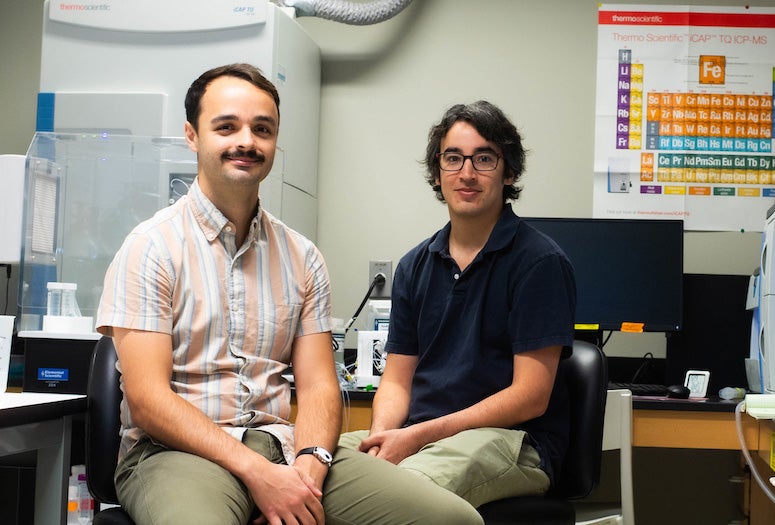Two Rice University scientists have received a 3-year grant from the Department of Energy (DOE) to investigate a form of carbon storage that is as little understood as it is ubiquitous: soil.

Mark Torres, an assistant professor of Earth, environmental and planetary sciences, and Evan Ramos, a postdoctoral fellow in the Torres lab, will track how key minerals form in a watershed to build a fuller picture of the processes that allow soil to store carbon as organic matter.
“Soil on Earth contains three times more carbon than the atmosphere,” Ramos said. “We want to understand the mechanisms that allow for organic carbon to be stabilized and remain in soil over a wide range of timescales, from the human to the geological.”
Torres explained that as rock is exposed to water and other substances in the environment, chemical reactions unfold that leave behind specific “signatures.” Rivers are natural carriers of such signatures, making a watershed region a dynamic “natural laboratory” for studying soil formation.
“If we measure the chemical composition of a river, we can identify all of the chemical reactions that occurred in its watershed including those involved in soil formation,” Torres said.
Prior research supports the view that clay plays a role in storing carbon derived from organic sources, so the researchers plan to analyze samples collected from different areas of the landscape and hydrosphere of the East River watershed in Colorado in search of “signature” traces of clay mineral formation.
“We want to know when and how clay minerals form because they’re these big, platy, flat minerals with a high surface area that basically shield the organic carbon in the soil,” Ramos said. “We think they protect that organic carbon from breakdown and allow it to grow in abundance.”
Despite the association between clay mineral formation and organic carbon storage in soil, quantifying these processes has remained a challenge. Using water lithium content as a proxy for clay formation, Ramos said the researchers will model the stabilization of organic carbon over time, providing a framework for interpreting these processes in other watersheds.
The resulting model could also improve predictions of carbon dioxide changes in the atmosphere by providing a more accurate basis for gauging how carbon derived from organic sources is cycled at the level of Earth’s crust.
“Soils store a ton of carbon,” Torres said. “And if that carbon was somehow to be lost from soils and added to the atmosphere, that would make climate change worse. We’re trying to understand what keeps carbon in soils, so we can get better at factoring in their role in climate models and render predictions of carbon dioxide changes in the atmosphere more detailed and accurate.”
In the long run, understanding how soils store carbon could help develop practices and incentives for a carbon market economy.
“Maybe there’s a way to harness Earth’s natural mechanisms of sequestering carbon to combat climate change,” Torres said. “But to do that, we first have to understand how soils actually work.”
Other co-investigators on the grant are Matthew Winnick, an assistant professor in the Earth, Geographic and Climate Sciences Department at University of Massachusetts Amherst; Daniel Ibarra, the Manning Assistant Professor of Earth, Environmental and Planetary Sciences, and Environment and Society at Brown University; and Kenneth Williams, a senior scientist at the Lawrence Berkeley National Laboratory in Berkeley, California.
- Image downloads:
-
https://news-network.rice.edu/news/files/2023/09/JWF_5405.jpg
CAPTION: Mark Torres (left) and Evan Ramos (Photo by Gustavo Raskosky/Rice University)
https://news-network.rice.edu/news/files/2023/09/JWF_5372.jpg
CAPTION: Evan Ramos (left) and Mark Torres (Photo by Gustavo Raskosky/Rice University) - Related stories:
-
Climate warming reduces organic carbon burial beneath oceans:
https://news.rice.edu/news/2023/climate-warming-reduces-organic-carbon-burial-beneath-oceans
Mark Torres wins Geochemical Society's Clarke Award:
https://news.rice.edu/news/2021/mark-torres-wins-geochemical-societys-clarke-award
- Links:
-
Torres lab: https://torres-lab.github.io/
Earth, environmental and planetary sciences department: https://eeps.rice.edu/
Wiess School of Natural Sciences: https://naturalsciences.rice.edu/ - About Rice:
-
Located on a 300-acre forested campus in Houston, Rice University is consistently ranked among the nation’s top 20 universities by U.S. News & World Report. Rice has highly respected schools of Architecture, Business, Continuing Studies, Engineering, Humanities, Music, Natural Sciences and Social Sciences and is home to the Baker Institute for Public Policy. With 4,552 undergraduates and 3,998 graduate students, Rice’s undergraduate student-to-faculty ratio is just under 6-to-1. Its residential college system builds close-knit communities and lifelong friendships, just one reason why Rice is ranked No. 1 for lots of race/class interaction and No. 4 for quality of life by the Princeton Review. Rice is also rated as a best value among private universities by Kiplinger’s Personal Finance.

